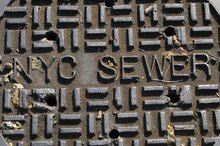How Long to Stay Out of a Building After Asbestos Removal
Containment and abatement of asbestos are the safest ways to protect yourself from this hazardous mineral. While there is not a set length of time to keep out of a recently cleared building, it is wise to observe a few procedures once the abatement is completed. Once the state-licensed removal team finishes clearing and cleaning the area, the Environmental Protection Agency (EPA) recommends hiring an unaffiliated inspector to ensure that all of the asbestos has been removed before resuming activity.
What is Asbestos?
The EPA defines asbestos as "the name given to a number of naturally occurring fibrous minerals with high tensile strength, the ability to be woven, and resistance to heat and most chemicals." While asbestos was used from ancient Egypt to modern times as a fire retardant in many buildings, it has since been proven to cause a number of destructive health problems including mesothelioma and lung cancer. The government has banned many forms of asbestos, although some remain legal. Because of the likelihood of asbestos eventually to decompose, releasing microscopic fibers that can tear and scar the lungs and other internal organs once inhaled, asbestos is best removed when it is damaged or sealed off when still intact.
- The EPA defines asbestos as "the name given to a number of naturally occurring fibrous minerals with high tensile strength, the ability to be woven, and resistance to heat and most chemicals."
- Because of the likelihood of asbestos eventually to decompose, releasing microscopic fibers that can tear and scar the lungs and other internal organs once inhaled, asbestos is best removed when it is damaged or sealed off when still intact.
How to Remove Asbestos
What Are the Dangers of Ethylene Vinyl Acetate?
Learn More
It is strongly recommended by the EPA that individuals do not undertake asbestos removal themselves. Both the EPA website and an independent information source, Asbestos.net, contain lists of federal- and state-licensed asbestos removal companies and labs 1. It is recommended that individuals hire an appraiser and unaffiliated remover to assess the need and then to carry out the work. Containment of the fibers is best accomplished by covering all walls, doors, floors and ceilings with a plastic tarp and securing that with duct tape. The plastic sheet and asbestos itself should remain wet during the removal process, so it will be too heavy to become airborne. Once the asbestos is scraped and removed, it must be placed into leak-proof plastic bags, sealed, taped over and labeled as hazardous material. Asbestos can only be disposed of in government-approved sites. Once all asbestos and the plastic sheets have been removed, protective clothing must be thoroughly cleaned, and the area should be vacuumed with a machine using a HEPA filter. This filter, too, should end up in a sealed plastic bag for disposal. To reiterate, it is strongly encouraged that individuals do not complete this process.
- It is strongly recommended by the EPA that individuals do not undertake asbestos removal themselves.
- Once all asbestos and the plastic sheets have been removed, protective clothing must be thoroughly cleaned, and the area should be vacuumed with a machine using a HEPA filter.
After Removal
Asbestos-abatement.com recommends another inspection after the removal phase to ensure that all asbestos has been cleared before the space or building is returned to use. The length of time between the removal and this final inspection is unimportant; once the asbestos is removed, it should be safe to re-enter. Checking to make sure the abatement has been successful is at your own discretion, but one can never be too careful.
- Asbestos-abatement.com recommends another inspection after the removal phase to ensure that all asbestos has been cleared before the space or building is returned to use.
- The length of time between the removal and this final inspection is unimportant; once the asbestos is removed, it should be safe to re-enter.
Related Articles
References
- EPA.gov: Asbestos-Basic Information
- Centers for Disease Control and Prevention. Agency for Toxic Substances and Disease Registry. Clinical Screening Guidelines for Asbestos-Related Disease.
- Occupational Safety and Health Administration. Asbestos.
- Camargo, M. et al. Occupational exposure to asbestos and ovarian cancer: a meta-analysis. Environmental Health Perspectives. 2011. 119(9):1211-7.
- Centers for Disease Control and Prevention (CDC). Asbestosis-related years of potential life lost before age 65 years – United States, 1968-2005. Morbidity and Mortality Weekly Report. 2008. 57(49:1321-5.
- Environmental Protection Agency. Asbestos. Updated 12/04/16. https://www.epa.gov/asbestos
- Fasola, G. et al. Low-dose computed tomography screening for lung cancer and pleural mesothelioma in an asbestos-exposed population: baseline results of a prospective, nonrandomized feasibility trial – an Alpe-andria Thoracic Oncology Multidisciplinary Group Study (ATOM 001). Oncologist. 2007. 12(10):1215-24.
- Jamrozik, E., deKlerk, N., and A. Musk. Asbestos-related disease. Internal Medicine Journal. 2011. 41(4):372-80.
- Liu, G., Cheresh, P., and D. Kamp. Molecular basis of asbestos-induced lung disease. Annual Reviews in Pathology. 2013. 24(8):161-87.
- Markowitz, S. et al. Asbestos, asbestosis, smoking, and lung cancer. New findings from the north American insulator cohort. American Journal of Respiratory and Critical Care Medicine. 2013. 188(1):90-6.
- Przakova, S. et al. Asbestos and the lung in the 21st century: an update. The Clinical Respiratory Journal. 2013 May 27. (Epub ahead of print)
- Roberts, H. et al. Screening for malignant pleural mesothelioma and lung cancer in individuals with a history of asbestos exposure. Journal of Thoracic Oncology. 2009. 4(5):620-8.
- Wender, R. et al. American Cancer Society lung cancer screening guidelines. CA: A Cancer Journal for Clinicians. 2013. 63(2):102-7.
Writer Bio
Emily Manthei holds a masters degree from the University of Edinburgh and has written for publications as diverse as the "Oxford Journal of Theological Studies," "Emanuel Levy Film Reviews," "USA Today" and "Northern Express Magazine." She also writes screenplays for short and feature films.







